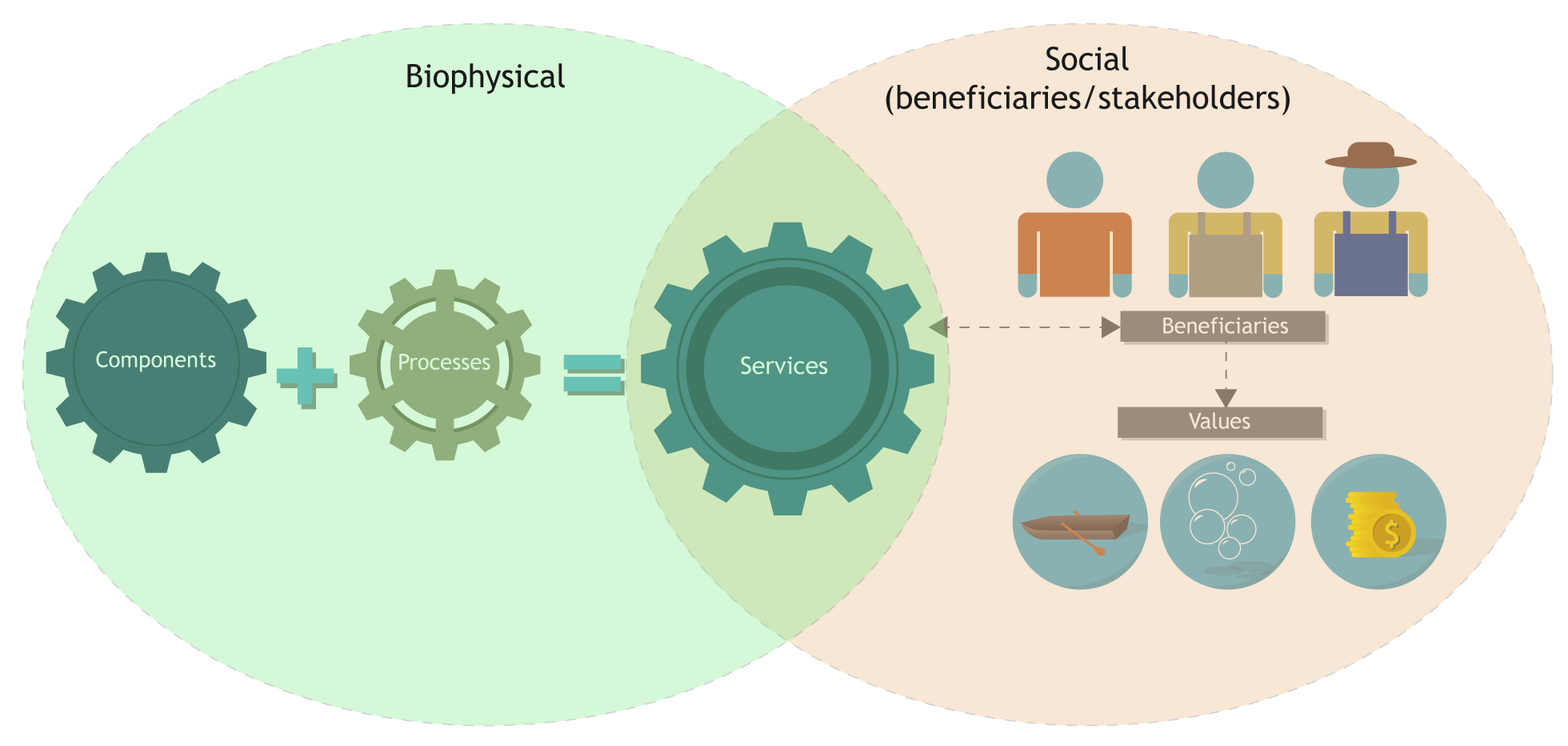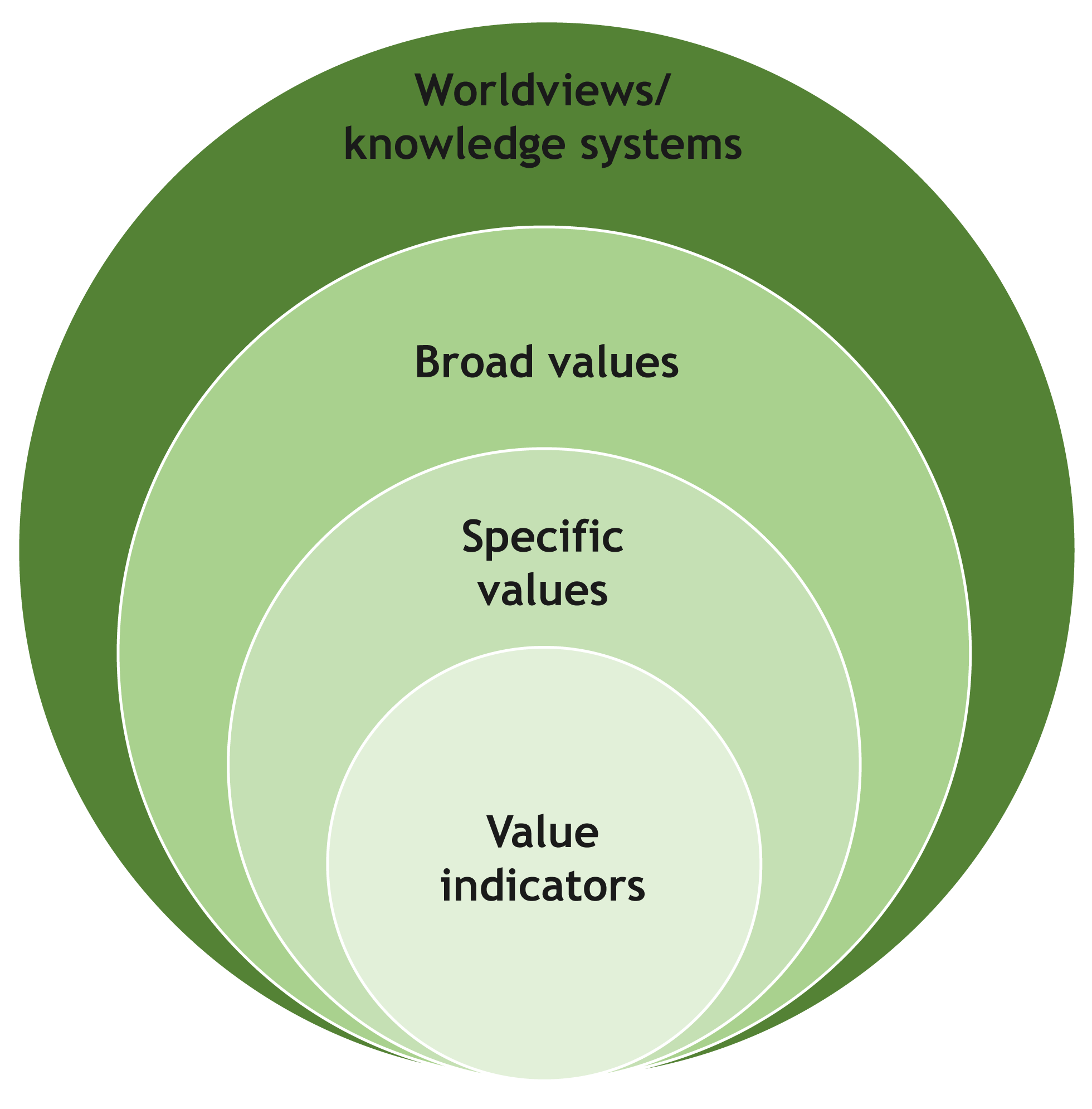|
|
Quick facts
- Social-ecological systems
-
are systems categorised by interactions between human (social) and biophysical (ecological) subsystems[6][9]. The term ‘social-ecological’ recognises that social and ecological subsystems are equally important (rather than using “socio” as a modifier) to the health of a system[2][4].

Why are values important?
Beneficiaries and stakeholders can value services for their economic, social, and cultural importance[22][10][19]. An ecosystem’s components and processes can also have intrinsic value for non-human beneficiaries[3][14][22]. Identifying what beneficiaries and stakeholders value and also including intrinsic values can help decision-makers understand what is important to those who rely on the environment. These values can also be used to measure and evaluate the effectiveness of rehabilitation activities[19][7][10].
Historically, management interventions have considered a narrow set of values and primarily focused on market values, either omitting or poorly considering the diverse values held by beneficiaries and stakeholders, that cannot be monetised[3][11][10]. However, because a wetland can be valued for many reasons, policies that favour a specific value type can lead to conflicts between beneficiaries and stakeholders who hold differing values[27][12][10]. Conflicts may also arise between beneficiaries and stakeholders who hold the same values for an ecosystem, but assign those values to a different part of an ecosystem (e.g. different components, locations within an ecosystem) or if those beneficiaries and stakeholders have different viewpoints on how to manage the ecosystem that they value[12]. On-ground managers and decision-makers should consider the biophysical, social, economic, and cultural values of an aquatic ecosystem when designing management interventions[18][12][13]. Active participation from beneficiaries and stakeholders in the planning, design, and implementation of a project using the Whole-of-System, Values-Based Framework can lead to the development of alternative management strategies that achieve outcomes that meet the biophysical needs of an environment and the values of a broad range of beneficiaries and stakeholders[29][19].
The formation of social, cultural and economic values can be traced from the biophysical components and processes interacting to generate a supply of services that stakeholders interact with[21][23][22] (see also the Whole-of-System, Values-Based Framework). These interactions generate a benefit (e.g. through labour and/or capital goods) that is then valued (individually or collectively) by beneficiaries or stakeholders[17][22][14][8].
 [17][22][8] [17][22][8]
Understanding exactly how and why beneficiaries and stakeholders value an ecosystem is complex[16][26]. For simplicity, the values that beneficiaries and stakeholders hold can be influenced by their worldviews, cultures, knowledge systems (e.g. Traditional Ecological Knowledge, academic, local), personal characteristics (e.g. age, income, gender, etc.) and connection to nature[22][5][19][12][22][20][10][24]. For example, some beneficiaries and stakeholders see people and nature as intertwined systems of life, while others view people and nature as distinctly separate[10]. A person’s values may influence their attitudes, management aspirations and behaviours within a social-ecological system[12][1].
A description of the worldviews that can influence the values that stakeholders and beneficiaries hold for a social-ecological system. Adapted from Jones et al. (2016)[12], O’Connor and Kenter (2019)[19] and Intergovernmental Platform on Biodiversity and Ecosystem Services (IPBES)(2022)[10].
| Worldview |
Emphasis |
| Anthropocentric |
Human-centred |
| Ecocentric |
Nature-centred |
| Pluricentric |
Centres the relationship between humans and non-human entities, including a system’s components and processes |
| Cosmocentric |
Centres the relationship between pluricentric and ecocentric worldviews and lives in harmony with all forms of existence, where both biotic and abiotic elements of nature are considered alive (e.g. kinship with the environment) |
Beneficiaries and stakeholders interact with the biophysical environment in different ways and can view the world through different “Life Frames”[15][19][10]. People can view themselves as “living from”, “living in”, “living with” and “living as” nature[19][10]. These different Life Frames can influence the values held by beneficiaries and stakeholders and be used to better identify, understand and categorise those values[15][19][10]. The Life Frames in which beneficiaries and stakeholders view the world are not mutually exclusive and a beneficiary or stakeholder could view the environment through multiple Life Frames depending on how they are interacting with the environment[10].
A description of the different Life Frames for identifying and understanding the values that beneficiaries and stakeholders assign to services, including their emphasis (e.g. anthropocentric vs. ecocentric). Adapted from O’Connor and Kenter (2019)[19]and IPBES (2022)[10].
| Life Frame |
Description |
Emphasis |
| Living from |
Nature is viewed as a resource for sustaining livelihoods, needs, wants, and providing sustenance (e.g. extractive use of an ecosystem) |
Anthropocentric |
| Living in |
Nature is viewed as a place for life events, including where social, cultural and recreational values are formed |
Anthropocentric |
| Living with |
Nature is viewed as providing essential life-supporting processes for non-human entities to co-exist alongside humans |
Ecocentric (can also be viewed as cosmocentric) |
| Living as |
Nature is viewed as being an essential part of oneself and comprising the physical, mental and spiritual part of self (e.g. kinship) |
Pluricentric (can also be viewed as cosmocentric) |
How are values categorised?
There are several different ways that can be used to categorise the values assigned to ecosystem services[25]. One method identifies how values are influenced by worldviews and knowledge systems[10]. Values can then be categorised into broad values (i.e. guiding principles and life goals, such as livelihood or stewardship) or specific values (i.e. the importance of nature in particular situations, such as cultural meanings of fishing or fish as part of kinship)[10].
 [10] [10]
Specific values can be broadly categorised into instrumental, intrinsic, or relational under the different Life Frames and broad values[19][10][16]. These values are also sometimes categorised into “use” (i.e. values derived from interaction or use of the resource, either directly or indirectly) vs. “non-use” (i.e. values not associated with use of the environment or a tangible benefit). Values can be measured using indicators and metrics[10][28].
A description of categories for classifying the values, including their emphasis (e.g. anthropocentric vs. ecocentric). Adapted from O’Connor and Kenter (2019)[19], Kenter and O’Connor (2022)[16] and IPBES (2022)[10].
| Specific value |
Definition |
Use type |
Emphasis |
| Instrumental |
Assigned to parts of nature that are used as a means to a desired end (e.g. as capital, a resource, etc.) and valued for its contributions to people |
Use |
Anthropocentric |
| Intrinsic |
See Wetland services and values |
Non-use |
Ecocentric |
| Relational |
Assigned to the parts of nature where people meaningfully engage with nature (e.g. through swimming, boating, hiking) and with other people through nature (e.g. sense of place, spirituality, care, reciprocity, sense of well-being) |
Non-use |
Anthropocentric |
Links
References
- ^ Bataille, CY, Malinen, SK, Yletyinen, J, Scott, N & Lyver, POB (August 2021), 'Relational values provide common ground and expose multi‐level constraints to cross‐cultural wetland management', People and Nature. [online], vol. 3, no. 4, pp. 941-960. Available at: https://onlinelibrary.wiley.com/doi/10.1002/pan3.10244 [Accessed 29 August 2022].
- ^ Berkes, F (13 July 2017), 'Environmental Governance for the Anthropocene? Social-Ecological Systems, Resilience, and Collaborative Learning', Sustainability. [online], vol. 9, no. 7, p. 1232. Available at: http://www.mdpi.com/2071-1050/9/7/1232 [Accessed 22 August 2022].
- ^ a b Chan, KMA, Satterfield, T & Goldstein, J (February 2012), 'Rethinking ecosystem services to better address and navigate cultural values', Ecological Economics. [online], vol. 74, pp. 8-18. Available at: https://linkinghub.elsevier.com/retrieve/pii/S0921800911004927 [Accessed 23 June 2021].
- ^ Colding, J & Barthel, S (2019), 'Exploring the social-ecological systems discourse 20 years later', Ecology and Society. [online], vol. 24, no. 1, p. art2. Available at: https://www.ecologyandsociety.org/vol24/iss1/art2/ [Accessed 22 September 2021].
- ^ Dutcher, DD, Finley, JC, Luloff, AE & Johnson, JB (July 2007), 'Connectivity With Nature as a Measure of Environmental Values', Environment and Behavior. [online], vol. 39, no. 4, pp. 474-493. Available at: http://journals.sagepub.com/doi/10.1177/0013916506298794 [Accessed 7 June 2021].
- ^ Gallopin, GC (1991), 'Human dimensions of global change: linking the global and the local processes', International Social Science Journal. [online], vol. 43, no. 4, pp. 707-718. Available at: https://www.researchgate.net/publication/279607019_Human_dimensions_of_global_change_linking_the_global_and_the_local_processes.
- ^ Guerrero, AM, Shoo, L, Iacona, G, Standish, RJ, Catterall, CP, Rumpff, L, de Bie, K, White, Z, Matzek, V & Wilson, KA (November 2017), 'Using structured decision‐making to set restoration objectives when multiple values and preferences exist', Restoration Ecology. [online], vol. 25, no. 6, pp. 858-865. Available at: https://onlinelibrary.wiley.com/doi/10.1111/rec.12591 [Accessed 14 September 2021].
- ^ a b Haines-Young, R & Potschin, MB (2018), Common international classification of ecosystem services (CICES) V5. 1 and guidance on the application of the revised structure. . .. [online], European Environment Agency (EEA). Available at: https://cices.eu/content/uploads/sites/8/2018/01/Guidance-V51-01012018.pdf.
- ^ Harrington, R, Anton, C, Dawson, TP, de Bello, F, Feld, CK, Haslett, JR, Kluvánkova-Oravská, T, Kontogianni, A, Lavorel, S, Luck, GW, Rounsevell, MDA, Samways, MJ, Settele, J, Skourtos, M, Spangenberg, JH, Vandewalle, M, Zobel, M & Harrison, PA (September 2010), 'Ecosystem services and biodiversity conservation: concepts and a glossary', Biodiversity and Conservation. [online], vol. 19, no. 10, pp. 2773-2790. Available at: http://link.springer.com/10.1007/s10531-010-9834-9 [Accessed 27 January 2021].
- ^ a b c d e f g h i j k l m n o p q r Intergovernmental Science-Policy Platform On Biodiversity And Ecosystem Services (9 July 2022), Summary for policymakers of the methodological assessment of the diverse values and valuation of nature of the Intergovernmental Science-Policy Platform on Biodiversity and Ecosystem Services (IPBES). [online], Zenodo. Available at: https://zenodo.org/record/6522392 [Accessed 12 July 2022].
- ^ IPBES (2018), Information on the scoping for the methodological assessment regarding the diverse conceptualization of multiple values of nature and its benefits, including biodiversity and ecosystem services (deliverable 3 (d)). [online], vol. 6/INF/9, Plenary of the Intergovernmental Science-Policy Platform on Biodiversity and Ecosystem Services Sixth session, Medellin, Colombia. Available at: https://ipbes.net/sites/default/files/ipbes-6-inf-9_en.pdf.
- ^ a b c d e f Jones, NA, Shaw, S, Ross, H, Witt, K & Pinner, B (2016), 'The study of human values in understanding and managing social-ecological systems', Ecology and Society. [online], vol. 21, no. 1, p. art15. Available at: http://www.ecologyandsociety.org/vol21/iss1/art15/ [Accessed 25 October 2021].
- ^ Jupiter, SD, Wenger, A, Klein, CJ, Albert, S, Mangubhai, S, Nelson, J, Teneva, L, Tulloch, VJ, White, AT & Watson, JEM (September 2017), 'Opportunities and constraints for implementing integrated land–sea management on islands', Environmental Conservation. [online], vol. 44, no. 3, pp. 254-266. Available at: https://www.cambridge.org/core/product/identifier/S0376892917000091/type/journal_article [Accessed 11 October 2021].
- ^ a b Kenter, JO, O'Brien, L, Hockley, N, Ravenscroft, N, Fazey, I, Irvine, KN, Reed, MS, Christie, M, Brady, E, Bryce, R, Church, A, Cooper, N, Davies, A, Evely, A, Everard, M, Fish, R, Fisher, JA, Jobstvogt, N, Molloy, C, Orchard-Webb, J, Ranger, S, Ryan, M, Watson, V & Williams, S (March 2015), 'What are shared and social values of ecosystems?', Ecological Economics. [online], vol. 111, pp. 86-99. Available at: https://linkinghub.elsevier.com/retrieve/pii/S0921800915000191 [Accessed 30 September 2021].
- ^ a b Kenter, JO (October 2018), 'IPBES: Don’t throw out the baby whilst keeping the bathwater; Put people’s values central, not nature’s contributions', Ecosystem Services. [online], vol. 33, pp. 40-43. Available at: https://linkinghub.elsevier.com/retrieve/pii/S2212041618301384 [Accessed 23 August 2022].
- ^ a b c Kenter, JO & O’Connor, S (28 July 2022), 'The Life Framework of Values and living as nature; towards a full recognition of holistic and relational ontologies', Sustainability Science. [online] Available at: https://link.springer.com/10.1007/s11625-022-01159-2 [Accessed 1 September 2022].
- ^ a b Landers, DH & Nahlik, AM (2013), Final ecosystem goods and services classification system (FEGS-CS). [online], vol. EPA/600/R-13/ORD-004914., United States Environmental Protection Agency (EPA).. Available at: https://www.epa.gov/eco-research/final-ecosystem-goods-and-services-fegs [Accessed 22 September 2020].
- ^ Oza, TM, Lane, R, Adame, MF & Reef, R (29 July 2021), 'Coastal wetland management in the Great Barrier Reef: Farmer perceptions', Geographical Research. [online], pp. 1745-5871.12497. Available at: https://onlinelibrary.wiley.com/doi/10.1111/1745-5871.12497 [Accessed 30 July 2021].
- ^ a b c d e f g h i j k O’Connor, S & Kenter, JO (September 2019), 'Making intrinsic values work; integrating intrinsic values of the more-than-human world through the Life Framework of Values', Sustainability Science. [online], vol. 14, no. 5, pp. 1247-1265. Available at: http://link.springer.com/10.1007/s11625-019-00715-7 [Accessed 24 March 2021].
- ^ Pascual, U, Balvanera, P, Díaz, S, Pataki, G, Roth, E, Stenseke, M, Watson, RT, Başak Dessane, E, Islar, M, Kelemen, E, Maris, V, Quaas, M, Subramanian, SM, Wittmer, H, Adlan, A, Ahn, SE, Al-Hafedh, YS, Amankwah, E, Asah, ST, Berry, P, Bilgin, A, Breslow, SJ, Bullock, C, Cáceres, D, Daly-Hassen, H, Figueroa, E, Golden, CD, Gómez-Baggethun, E, González-Jiménez, D, Houdet, J, Keune, H, Kumar, R, Ma, K, May, PH, Mead, A, O’Farrell, P, Pandit, R, Pengue, W, Pichis-Madruga, R, Popa, F, Preston, S, Pacheco-Balanza, D, Saarikoski, H, Strassburg, BB, van den Belt, M, Verma, M, Wickson, F & Yagi, N (June 2017), 'Valuing nature’s contributions to people: the IPBES approach', Current Opinion in Environmental Sustainability. [online], vol. 26-27, pp. 7-16. Available at: https://linkinghub.elsevier.com/retrieve/pii/S1877343517300040 [Accessed 12 December 2021].
- ^ a b Rendón, OR, Garbutt, A, Skov, M, Möller, I, Alexander, M, Ballinger, R, Wyles, K, Smith, G, McKinley, E, Griffin, J, Thomas, M, Davidson, K, Pagès, JF, Read, S & Beaumont, N (December 2019), 'A framework linking ecosystem services and human well‐being: Saltmarsh as a case study', People and Nature. [online], vol. 1, no. 4, pp. 486-496, ed. A Fischer. Available at: https://onlinelibrary.wiley.com/doi/10.1002/pan3.10050 [Accessed 16 August 2022].
- ^ a b c d e f g h Scholte, SSK, van Teeffelen, AJA & Verburg, PH (June 2015), 'Integrating socio-cultural perspectives into ecosystem service valuation: A review of concepts and methods', Ecological Economics. [online], vol. 114, pp. 67-78. Available at: https://www.researchgate.net/publication/274196760_Integrating_socio-cultural_perspectives_into_ecosystem_service_valuation_A_review_of_concepts_and_methods/link/5a5f3c59a6fdcc68fa9a463b/download [Accessed 30 May 2022].
- ^ a b Small, N, Munday, M & Durance, I (May 2017), 'The challenge of valuing ecosystem services that have no material benefits', Global Environmental Change. [online], vol. 44, pp. 57-67. Available at: https://linkinghub.elsevier.com/retrieve/pii/S0959378017303540 [Accessed 18 August 2022].
- ^ Sockhill, NJ, Dean, AJ, Oh, RRY & Fuller, RA (14 September 2022), 'Beyond the ecocentric: Diverse values and attitudes influence engagement in pro‐environmental behaviours', People and Nature. [online], p. pan3.10400. Available at: https://onlinelibrary.wiley.com/doi/10.1002/pan3.10400 [Accessed 19 September 2022].
- ^ Tadaki, M, Sinner, J & Chan, KMA (2017), 'Making sense of environmental values: a typology of concepts', Ecology and Society. [online], vol. 22, no. 1, p. art7. Available at: http://www.ecologyandsociety.org/vol22/iss1/art7/ [Accessed 13 December 2021].
- ^ The economics of ecosystems & biodiversity (2010), 'The Economics of Ecosystems and Biodiversity: Mainstreaming the economics of nature: a synthesis of the approach, conclusions and recommendations of teeb'. [online], p. 36, UNEP, Geneva, ed. TEEB. Available at: https://www.teebweb.org/wp-content/uploads/Study%20and%20Reports/Reports/Synthesis%20report/TEEB%20Synthesis%20Report%202010.pdf.
- ^ Trainor, SF (1 February 2006), 'Realms of Value: Conflicting Natural Resource Values and Incommensurability', Environmental Values. [online], vol. 15, no. 1, pp. 3-29. Available at: https://www.ingentaconnect.com/content/10.3197/096327106776678951 [Accessed 28 August 2022].
- ^ U.S. Environmental Protection Agency (2020), Metrics for national and regional assessment of aquatic, marine, and terrestrial final ecosystem goods and services. [online], vol. EPA645/R-20-002, U.S. Environmental Protection Agency. Available at: https://cfpub.epa.gov/ncea/risk/recordisplay.cfm?deid=351538.
- ^ van Riper, CJ, Thiel, A, Penker, M, Braito, M, Landon, AC, Thomsen, JM & Tucker, CM (2018), 'Incorporating multilevel values into the social-ecological systems framework', Ecology and Society. [online], vol. 23, no. 3, p. art25. Available at: https://www.ecologyandsociety.org/vol23/iss3/art25/ [Accessed 5 September 2022].
Last updated: 24 March 2023
This page should be cited as:
Department of Environment, Science and Innovation, Queensland (2023) Values, WetlandInfo website, accessed 25 June 2024. Available at: https://wetlandinfo.des.qld.gov.au/wetlands/management/wetland-values/values/
|

 — Department of Environment, Science and Innovation
— Department of Environment, Science and Innovation





